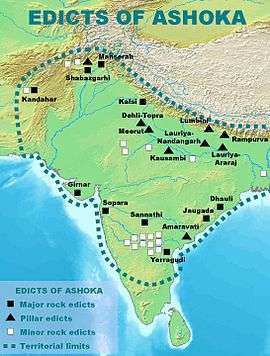Amaravathi Mahachaitya
| Amaravathi Mahachaitya | |
|---|---|
|
Distribution of the Edicts of Ashoka[1] | |
| Location | Amaravathi, Andhra Pradesh, India |
| Height | 73 m (241 ft) |
| Built | 3rd Century BCE |
| Pilgrimage to |
| Buddha's Holy Sites |
|---|
 |
| The Four Main Sites |
| Four Additional Sites |
| Other Sites |
| Later Sites |
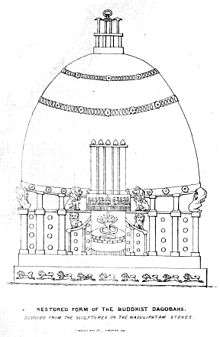
The Amarāvatī Mahācaitya, popularly known as the great stūpa at Amarāvathī, is a ruined Buddhist monument located at Amaravathi village, Guntur district, Andhra Pradesh, India. The site is under the protection of the Archaeological Survey of India. The campus includes the stūpa itself and the Archaeological Museum.[2] The important sculptures from the site are now deposited in a number of museums in India and abroad. A list of collections is given below.
Name of the site
The name Amaravathi is relatively modern, having been applied to the town and site after the Amareśvara Liṅgasvāmin temple was built in the eighteenth century.[3] The oldest maps and plans, drawn by Colin Mackenzie and dated 1816, label the stūpa simply as the deepaldinna or 'hill of lights'.[4] The monument was not called a stūpa in ancient inscriptions, but rather the mahācetiya or great sanctuary.[5]
History
The mahācetiya was probably founded in the third century BCE in the time of Asoka but there is no decisive evidence for the foundation.[6] The earliest inscription from the site belongs to the early centuries BCE but it cannot be assign to Aśoka with certainty.[7]
The main construction phases of Amaravati fall in two main periods, with the additions consisting of railings (vedikā) and carved slabs placed against the stūpa proper. These slabs are usually called 'drum slabs' because they were placed round the base of the stūpa which has a shape similar to a circular drum.[8] In the early period (circa 200-100 BCE), the stūpa had a simple railing consisting of granite pillars, with plain cross-bars, and coping stones. The coping stones with youths and animal reliefs, the early drum slabs, and some other early fragments belong to this period. The stūpa must have been fairly large at this time, considering the size of the granite pillars (some of which are still seen in situ, following excavations).
The late period of construction started around ca. 50 BCE and continued until circa 250 CE. This period is divided this period into three phases by Akira Shimada on the basis of the dates that can be assigned to parts of the great limestone railing.[8] The first phase is 50-0 CE, and the same period as the Sanchi stūpa I gateways. The second phase is 50-100 CE, the same period as Karli caitya and the Pandavleni Caves (no. 3 and 10) at Nasik. The third phase is circa 200-250 CE based on comparisons with Nagarjunakonda sculpture. Some other types of sculpture of belong to an even later time, about the seventh or eighth centuries, and include standing Bodhisattvas and goddesses. Amaravātī continued to be active after this time, probably to about the thirteenth century..
Recovery
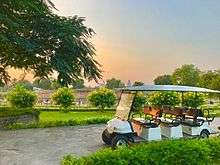
Westerners were first alerted to the ruins of the Stupa at Amaravati after a visit in 1797 by Major Colin Mackenzie.[9] On the right bank of the Krishna River[10] in the Andhra district of southeast India, Mackenzie came across a huge Buddhist construction built of bricks and faced with slabs of limestone.[11] By the time he returned in 1816, indiscriminate excavations had already destroyed what remained of the structure and many of the bricks had been reused to build local houses.[9] Mackenzie carried out further excavations, recorded what he saw and drew a plan of the stupa.[12]
In 1845, Sir Walter Elliot of the Madras Civil Service explored the area around the stupa and excavated near the west gate of the railing, removing many sculptures to Madras (now Chennai). They were kept outside the local college before being transported to the Madras Museum. At this time India was run by the East India Company and it was to that company that the curator of the museum appealed. The curator Dr Edward Balfour was concerned that the artefacts were deteriorating so in 1853 he started to raise a case for them to be moved. By 1855, he had arranged for both photographs and drawings to be made of the artifacts, now called the Elliot Marbles. 75 photographs taken by Captain Linnaeus Tripe are now in the British Library. The sculptures were exported to London in 1859.[13] Robert Sewell made further excavations in the 1880s, recording his excavations in some detail with drawings and sketches but not in the detail that would now be expected.[9]
Plans have also been put in place to create a purpose built exhibition space for the sculptures still in India. Those marbles not in an air-conditioned store were said to show signs of damage from the atmosphere and salt.[13] The Chennai museum has plans for an air-conditioned gallery to install the sculptures, but these goals have yet to be realised.[14]
Sculptures
The region between the Krishna and Godavari rivers was an important place for Buddhism from the 2nd century BCE onwards. A Buddhist stupa was built during the reign of Ashoka in 200 BCE, was carved with panels that tell the story of Buddha. The story of the sculpture, including their discovery, misuse and destruction and subsequent preservation & distribution to various museums (Chennai, Calcutta, London, Masulipatnam etc.) has been poignantly described by Shimada.[15] During the period of the decline of Buddhism, this stupa was neglected and was buried under rubble. A 14th-century inscription in Sri Lanka mentions repairs made to the stupa, and after that it was forgotten. The stupa is related to the Vajrayana teachings of Kalachakra, still practiced today in Tibetan Buddhism.[16] Dalai Lama of Tibet conducted a Kalachakra initiation at this location in 2006.
Art historians regard the art of Amaravati as one of the three major styles or schools of ancient Indian art, the other two being the Mathura style, and the Gandharan style. The Amravati school of art had great influence on art in Sri Lanka and South-East Asia as products from here were carried to those countries. It also had influence over South Indian sculpture.
The Chinese traveller and Buddhist monk Hiuen Tsang (Xuanzang) visited Amaravati in 640 CE, stayed for sometime and studied 'Abhidhammapitakam'. Xuanzang wrote a glorious account of the place, Viharas and monasteries that existed.[17]
-
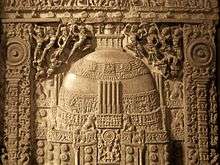
Relief from the side of the stūpa, now at the Government Museum in Chennai
-

Buddha Preaching in Tushita Heaven, now at Indian Museum in Kolkata
-
Sculptures at the Archaeological Museum, Amaravati
-
The Great Departure, from Amaravati
-
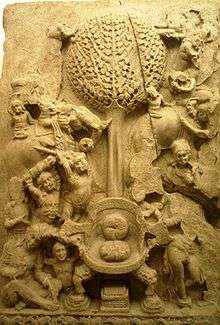
A representation of Mara's assault on the Buddha, depicted in aniconic form, 2nd century AD, Amaravati. Guimet Museum, Paris]]
Amaravati School
| Wikimedia Commons has media related to Ancient art of Amaravati. |
A different type of art form evolved and flourished in Amaravati for nearly six centuries, commencing from 200-100 BCE. Patronized first by the Satavahanas and later by the Ikshvakus and other groups (feudatories, officials, and merchants), four periods of activity are easily discernible.[18]
The Amaravati school of art occupies a pre-eminent position in the history of Indian Art. With its beginning in 3rd century BCE, the Amaravati unfolds its chapters through the galaxy of sculptural wealth that once adorned the Mahachaitya - the majestic monument of the Buddhists situated here with its history extending over a period of a millennium and a half.[19]
The Colin Mackenzie album
This album of drawings of Amarāvatī is a landmark in the history of archaeology in India. The pictures were made in 1816 and 1817 by a team of military surveyors and draftsmen under the direction of Colonel Colin Mackenzie (1757-1821), the first Surveyor-General of India.[20]
The album contains maps, plans and drawings of sculpture from the stūpa at Amarāvatī. The album is preserved in the British Library with a second copy in Kolkatta.[21]
Amarāvatī sculptures worldwide
All of the sculptures have been removed from the site of the Mahācetiya, although a few broken pillars remain. Museums across India and around the world have specimens from Amarāvatī. These collections are being brought together in the World Corpus of Amarāvatī Sculpture, a digital project agreed to and jointly developed by the Archaeological Survey of India and the British Academy, London.[22] Key collections of sculpture are held in the following places.
France
India
- National Museum of India, New Delhi[24]
- Government Museum, Chennai[25]
- State Museum, Hyderabad
- Chhatrapati Shivaji Maharaj Vastu Sangrahalaya, Mumbai[26]
- Indian Museum, Kolkatta
- State Museum, Pudukkottai
- Archaeological Museum, Amaravathi[2]
- Baudhasree Archaeological Museum, Vijayawada
- State Museum Lucknow, Lucknow
- Patna Museum, Patna
Singapore
United Kingdom
- The British Museum, London (see Amaravati Marbles)[28]
United States
- University of Pennsylvania Museum of Archaeology and Anthropology, Philadelphia[29]
- Museum of Fine Arts, Boston[30]
- Freer Gallery of Art, Washington, D.C.[31]
- Seattle Art Museum, Seattle
References
| Wikimedia Commons has media related to Stupa of Amaravati. |
- ↑ Reference: "India: The Ancient Past" p.113, Burjor Avari, Routledge, ISBN 0-415-35615-6
- 1 2 "Archaeological Museum, Amaravati - Archaeological Survey of India".
- ↑ South Indian languages do not distinguish aspirated and unaspirated consonants, thus Amarāvatī can appear as Amarāvathī, Ratana as Rathana, etc.
- ↑ For link to maps and plans at the British Library: The Amaravati Album
- ↑ Pia Brancaccio, The Buddhist Caves at Aurangabad: Transformations in Art and Religion (Leiden: Brill, 2011), p. 47.
- ↑ Akira Shimada, Early Buddhist Architecture in Context The Great Stūpa at Amarāvatī (Ca. 300 BCE-300 CE). Leiden: Brill, 2013. doi:10.1163/9789004233263
- ↑ See Harry Falk, Aśokan Sites and Artefacts: A Source-Book with Bibliography (Mainz: Von Zabern, 2006).
- 1 2 Akira Shimada, Early Buddhist Architecture in Context The Great Stūpa at Amarāvatī (Ca. 300 BCE-300 CE). Leiden: Brill, 2013.
- 1 2 3 Buddha, ancientindia.co.uk, retrieved 19 December 2013
- ↑ Erdosy, George; et al. (1995). The archaeology of early historic South Asia: the emergence of cities and states (1. publ. ed.). Cambridge: Cambridge University Press. p. 146. ISBN 0521376955.
- ↑ Amravati, PilgrimTrips, retrieved 12 January 2014
- ↑ Government Museum Website Government Museum homepage (and then click on "Archaeology", Chennai Museum, Tamilnadu, retrieved 11 January 2014
- 1 2 Roy, Amit (December 1992). "Out of Amatavati". IndiaToday. Retrieved 21 December 2013.
- ↑ "History in stone". The Hindu. 28 January 2002. Retrieved 22 December 2013.
- ↑ Early Buddhist Architecture in Context: The Great Stūpa at Amarāvatī (ca. 300 BCE-300 CE) by Akira Shimada, Brill, 2012, 322 pages; ISBN 9004233261, 9789004233263
- ↑ Kilty,G Ornament of Stainless Light, Wisdom 2004, ISBN 0-86171-452-0
- ↑ Travels of Xuanzang
- ↑ Reshma Rai. "What were the salient features of Amaravati School?". preservearticles.com.
- ↑ "Archaeological Museum, Amaravati - Archaeological Survey of India". asi.nic.in.
- ↑ Howes, Jennifer (2002). "Colin Mackenzie and the Stupa at Amaravati". South Asian Studies. 18: 53–65. doi:10.1080/02666030.2002.9628607.
- ↑ For link to the British Library album: http://www.bl.uk/onlinegallery/features/amaravati/homepage.html
- ↑ See: http://www.basas.org.uk/site/index.php/our_work/page/689aaf33-c326-4090-a60d-dc6950adffa5/
- ↑ http://www.guimet.fr/fr/documentation/glossaire?word=Amarâvatî
- ↑ "National Museum, New Delhi".
- ↑ "Government Museum Chennai".
- ↑ Virtual Museum of Images and Sound - VMIS. "Collections-Virtual Museum of Images and Sounds".
- ↑ "Singapore And India Sign Agreement : Ministry of Information, Communications and The Arts Press Release, 1 March 2003".
- ↑ "British Museum - Room 33a: Amaravati". British Museum.
- ↑ "Search Results for: Amaravati - Penn Museum Collections".
- ↑ "Search". Museum of Fine Arts, Boston.
- ↑ "Object - Online - Collections - Freer and Sackler Galleries". Freer - Sackler.
